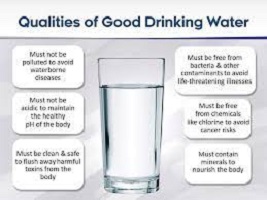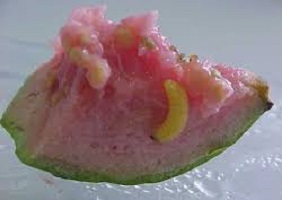Qualities of Good Drinking Water: Water Features
Qualities of Good Drinking Water: Characteristics of Water

Water
Water is a chemical compound with the formula H2O, in which two hydrogen atoms are covalently bound to a single oxygen atom in each molecule.
It is extremely important to animals and plants, as they utilize it for a variety of purposes. Some even go so far as to argue that “water is life.”
Potable Water
The term “potable water” refers to water that is fit for human consumption (i.e., water that can be used for drinking or cooking). The word means that the water is both safe and drinking.
Water that is drinkable is free of unpleasant scents, tastes, and colors, and is within normal temperature limits (Dugan, 1972). Toxins, carcinogens, pathogenic microorganisms, and other health concerns are not present in safe water (US National Academy of Sciences, 1977–82).
Some activities may be impossible to carry out without water.
Water is necessary for life to exist, and everyone should have access to a sufficient (appropriate, safe, and accessible) supply. Improving access to safe drinking water can have a direct impact on one’s health.
Every effort should be made to achieve the safest possible drinking water quality.
Drinking Water Quality ~ an Overview
Safe drinking water and of good quality is acceptable for all common household needs, including personal hygiene
However, higher-quality water may be necessary for some particular applications, such as renal dialysis and contact lens cleaning, as well as for some food processing and pharmaceutical applications.
Due to their vulnerability to organisms that cause infection, those who are severely immune-compromised may need to take extra precautions, such as boiling drinking water because of their vulnerability to organisms that aren’t generally an issue in drinking water
Let’s take a look at the physical and chemical properties of water.
Properties of Water – Qualities of Good Drinking Water
A view of the world from space will reveal it to be blue. This blue color is water; water covers the majority of the world.
We require water for virtually everything, including drinking, bathing, and cooking, therefore we should be familiar with its qualities. Water makes up 65 % of the human body.
Water is necessary for life to exist on this planet. On the surface of the earth, water is spread unevenly. It is a significant solvent that dissolves nearly all polar solutes.
So, let’s take a look at its characteristics and see why they’re important:
Physical properties of water: Water Quality
Water is a tasteless, colorless liquid. Water molecules have a lot of hydrogen bonding, which gives them strange qualities when it’s condensed.
High melting and boiling points result as a result of this. Water has a higher specific heat, thermal conductivity, surface tension, dipole moment, and other properties than other liquids.
These characteristics account for its importance in the biosphere. Because water is a good solvent, it aids in the transfer of ions and molecules needed for metabolism.
It has a high latent heat of vaporization, which aids in body temperature regulation.
5 Physical Characteristics of Water | Water Management
- Suspended Solids
- Turbidity
- Color
- Taste and Odour
- Temperature
Chemical Properties of Water – Qualities of Good Drinking Water
Water reacts with a wide range of substances to produce a variety of chemicals. The following are some notable reactions
The oxygen atom in the water molecule has two lone pairs, one of which could form a bond with a proton, allowing the water molecule to act as a base in a reaction. Water is amphoteric because it can act as both an acid and a base.
Example
Acidic Behaviour:
⇌
Basic Behavior:
⇌
Redox reactions
Water is reduced to a hydrogen molecule by electropositive elements. As a result, water is an excellent supplier of hydrogen. Let’s take a look at an example in this case:
Chemical Properties of Water
Water reacts with a wide range of substances to produce a variety of chemicals. The following are some notable reactions:
- Nature is amphoteric:
Water is amphoteric because it can act as both an acid and a base.
Example:
Acidic behavior:
⇌
Basic Personality Traits:
⇌
- Redox reactions include:
Water is reduced to a hydrogen molecule by electropositive elements. As a result, water is an excellent supplier of hydrogen. Let’s take a look at an example in this case:
Water is oxidized to O2 during the photosynthesis process. Water is particularly important in redox reactions because it may be oxidized and reduced.
Uses of Water – Qualities of Good Drinking Water
- Water can be drunk/consumed
- It can be used to wash
- It can be used for baths.
- And it can also be used in cooking
Hydrolysis reaction
Because of its dielectric constant, water has a very strong hydrating propensity. It dissolves a wide variety of ionic compounds and can hydrolyze several covalent and ionic molecules.
Water Resources: Sources of Water
Water covers over three-quarters of the Earth’s surface.
There are two main sources of water;
- Surface Water
These are the waters that have covered the land’s surface. Rivers, lakes, and other bodies of water
- Ground Water
These are the waters found beneath the earth’s surface and between rock fractures.
Important fact: Groundwater accounts for 20% of the world’s total water supply.
The cleanest sources of surface water and groundwater must be preserved for potable water supply purposes (Schwartz et al., 1990).
Potable water must meet numerous physical, chemical, microbiological, and radionuclide (q.v.) standards for both the untreated (raw) water sources and the treated water.
Water’s Functions: Uses of Water
- Firstly, water can be consumed/drunk.
- It can be used to wash
- Then, water can be used to take a bath.
- It can also be used in the kitchen for cooking
5 characteristics of healthy drinking water – Qualities of Good Drinking Water
- It is odorless (it has no smell)
- Healthy water is free of visible solid particles
- It is not contaminated; there are no harmful toxins or chemicals present.
- The water is mineral-rich.
- The water has no taste. However, it may taste nice because when one drinks good water, he or she is compelled to drink more, especially if thirsty and dehydrated.
What is the distinction between water and other liquids?
- Other liquids have odors, but water is odorless.
- Secondly, water is colorless, while other liquids are colored.
- For example, water is always clear, but liquid soap comes in a variety of colors, including green, yellow, and blue. Coca-cola is black, while Fanta is orange.
- Lastly, water has no taste, but other liquids do.
People also ask
What are the 5 qualities of good water?
Characteristics of Potable Water:
- Should be transparent.
- It should be free from impurities such as suspended solids.
- It should contain some minerals and salts, necessary for our body, and some dissolved gases to add taste.
- Potable water should be colorless and odorless
- It should be free from harmful microorganisms.
What are the 8 qualities of good drinking water?
However, there are eight key important characteristics of a water quality measurement: clarity, temperature, conductivity, pH, alkalinity, chlorine, hardness, and dissolved oxygen.
What should be the quality of drinking water?
Currently, the standard for treated drinking water is that coliform organisms be found in less than 1% of samples.
Most years, there are 20 to 30 incidents in which at least two people become ill from the same water source, with an annual total of 2000 to 3000 illnesses.
What are the qualities of pure water?
Pure water is virtually colorless, odorless, and tasteless.
What are the 7 indicators of water quality?
They comprise of dissolved oxygen, temperature, pH, salinity, and nutrients (nitrogen and phosphorus).
They also include toxicant levels such as insecticides, herbicides, and metals.
What are the 7 water quality parameters?
Parameters that are frequently sampled or monitored for water quality include temperature, dissolved oxygen, pH, conductivity, ORP, and turbidity.
However, total algae, ISEs (ammonia, nitrate, chloride), or laboratory parameters such as BOD, titration, or TOC may also be measured during water monitoring.
What are the six water quality factors?
Temperature, acidity (pH), dissolved solids (specific conductance), particulate matter (turbidity), dissolved oxygen, hardness, and suspended sediment are examples of these.
What are the six properties of drinking water?
The chemical and physical properties of water
- Ph value. The ph value of water is a measure of its acidity or alkalinity.
- Hardness. Water hardness is caused by dissolved salts of calcium and magnesium.
- Color.
- Radioactivity.
- Turbidity.
- Taste and odor.
What are the 9 characteristics of water?
Unique properties of water
- Water is polar
- An excellent solvent.
- Water has a high heat capacity.
- Has high heat of vaporization.
- Water has cohesive and adhesive properties.
- Water is less dense as a solid than as a liquid.
What 3 things determine water quality?
Which factors determine water quality? Water quality is determined by:
- The presence and quantity of contaminants
- Physical/ chemical factors such as pH and conductivity
- By the number of salts present and by the presence of nutrients.
What are the 4 main qualities of water?
The four unique properties of water that make it unique are high specific heat, high polarity, adhesion cohesion, and a lower density as a solid.
Water’s high specific heat allows it to absorb heat energy without changing temperature.
How do you judge water quality?
Measuring Water Quality
- The temperature of the water can affect it in many different ways.
- Dissolved Oxygen (DO) Oxygen is necessary for many aquatic species to survive
- Turbidity
- PH (acidity)
What is the pH level of water?
PH is a measure of how acidic/basic water is. The range goes from 0 to 14, with 7 being neutral. pHs of less than 7 indicate acidity, whereas a pH of greater than 7 indicates a base.
The pH of water is a very important measurement concerning water quality
What are the 4 types of drinking water?
Different Types of Water:
- Tap Water. The water that you get from your faucet is called tap water
- Packaged Drinking Water/Bottled water
- Spring Water or Glacier Water
- Mineral Water
- Well Water.
- Distilled Water
- Hard WaterAlkaline Water.
What are the 9 types of drinking water?
Here are the different types of water and what you should know about them.
- Tap water.
- Mineral water.
- Spring or glacier water
- Distilled water
- Purified water
- Sparkling water
- Flavored or infused water.
- Alkaline water.
What are the 10 physical properties of water?
These are:
- In appearance, the water is colorless and odorless. …
- Freezing point. Freezing can be described as a temperature when a liquid starts turning into ice.
- Specific Heat Capacity.
- Surface Tension of Water.
- Refractive Index of Water
- Density of Water
- The viscosity of Water.
- Dielectric Constant of Water
What are the 3 most important properties of water in life?
Polarity, Cohesion, and Adhesion
The phrase “opposites attract” sums up the significance of water’s polarity. Positive-negative attraction governs how water behaves in critical ways.
What pH is bad for water?
6.5
A pH of less than 7 makes the water acidic, while a pH greater than 7 makes water alkaline (basic).
The danger of acidic water (pH less than 6.5) is that it can leach metals from the well and the pipes that bring you water.
What is the full meaning of pH?
Potential of hydrogen
Hydrogen potential; is a measure of a solution’s acidity or alkalinity equal to the common logarithm of the reciprocal of the concentration of hydrogen ions in moles per cubic decimetre of solution.
The pH of pure water is 7, acid solutions have a pH less than 7, and alkaline solutions have a pH greater than 7.
What is the best pH for drinking water?
Between 6.5 and 8.5
EPA guidelines state that the pH of tap water should be between 6.5 and 8.5.
What are 5 tips to drink more water?
Here are some tips for upping your water game:
- Flavor it. Add fruit to your water.
- Tie it into a routine. Drink a glass of water every time you brush your teeth, eat a meal, or use the bathroom.
- Eat it.
- Track it.
- Challenge a friend.
- Take it to go.
- Alternate your drinks.
What is the best quality of water?
- Mountain Valley Spring Water at Amazon is the best overall. Go to the Review section.
- Topo Chico Mineral Water is the best mineral water on Amazon. Go to the Review section.
- The best alkaline water is Essentia Alkaline Water, which is available on Amazon. Go to the Review section.
- Amazon has the best filtered Waiakea Hawaiian Volcanic Water. Go to the Review section.
- Acqua Panna Spring Water at Amazon is the best high-end option.
Which water is the healthiest?
Mineral, structured, and pure spring water are among the healthiest waters you can drink because they are clean and contain all of the minerals your body requires.
Filtered water removes contaminants while also potentially removing essential minerals.
What kind of water should you drink daily?
You can use the following rule-of-thumb equation described in US News & World Report to help you establish a baseline.
In a nutshell, the equation states that you should drink half your body weight in ounces of water.
In the example, you should drink more than 12 glasses of water, not just eight!
What water should you drink daily?
Men should drink 15.5 cups (3.7 liters) of fluids per day. Women should drink 11.5 cups (2.7 liters) of fluids per day.
What are the three primary types of water?
The Three Different Types of Water?
- Ice is solid water that has been frozen. Water molecules move farther apart when it freezes, making ice less dense than water.
- Liquid water is moist and pliable. This is the type of water we are most familiar with.
- Water as a gas – vapor is always present in the air around us.
What color is water?
The water is not colorless; even pure water has a slight blue tint to it, which is best seen when looking through a long column of water.
The blueness of water is not caused by light scattering, which is responsible for the blueness of the sky.
What are the physical characteristics of drinking water?
Water’s physical properties (temperature, color, taste, odor, and so on) are determined by the senses of touch, sight, smell, and taste.
Temperature by touch, for example, color, floating debris, turbidity, and suspended solids by sight, and taste and the odor by smell
What is the physical quality of water?
Physical characteristics of water quality
Color – pure water is colorless; colored water may be a sign of pollution. Organic substances can also be revealed by color.
The maximum acceptable level for drinking water color is 15 TCU (True color unit). Turbidity – clear water that does not absorb light.


